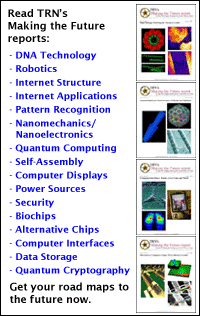
Badge controls displays
By
Eric Smalley,
Technology Research NewsRooms and public spaces that sense human presence, notice where attention is focused, and recognize gestures and spoken commands promise to make interacting with computers as natural as interacting with people.
Technology that enables smart spaces -- computer vision, gaze tracking and speech and gesture recognition -- is available. These cutting-edge components are expensive and difficult to combine into a smoothly functioning system, however. They also introduce privacy issues.
Researchers at Lancaster University in England have achieved some smart space capabilities by instead combining several more established technologies: wireless communications, local area networks and Internet access. The scheme also promises to protect users' privacy.
The system causes screens near a user to display Internet-based information that the user is likely to prefer. It can also be used to control CD players and other media devices.
The system hinges on the pendle, a device that can be worn around the neck. The pendle contains a computer, wireless transmitter, acceleration sensor and touch sensor. It automatically transmits user preferences to nearby computers and can also be taken in hand to perform command gestures, said Nicolas Villar, a research associate at Lancaster University.
The other components of the system -- wireless receivers, display devices and a computer that locates appropriate content -- are connected to a local area network. Simply by wearing the device, a user is able to inform computers in the environment of his preferences so that the environment can best tailor its behavior to match the user's interests, said Villar.
The pendle stores lists of keywords and Internet addresses chosen by the user and transmits these to receivers placed around the room. The nearest receiver forwards the information along with its own identification to a computer that locates the display device nearest the user.
If the information transmitted by a user's pendle is an Internet address, the display locates the address and shows the page or clip. If the pendle transmits a list of keywords, the computer searches the Internet for relevant information and forwards an appropriate Internet address to the display device.
When the user picks up the pendle, its touch sensor switches the device to command mode. Holding it up causes the nearest display to access the next Internet address stored in the pendle. Shaking the pendle removes the current information from display.
The system can also be used to control sound clips. Shaking the pendle to the right, for example, can signal a device to advance a CD to the next track, said Villar.
The system makes it unnecessary to use computers that see and hear to determine a person's context, said Villar. "The pendle provides an easier way for the environment to make a guess at [a user's] intentions by providing a defined list of the user's preferences," he said. This also allows a user to determine what information to make available to the system.
Though pendles require unique ID's to allow users to issue commands, the IDs do not have to be linked to users' identities, according to Villar.
Similar technologies exist, including pendants for gesture control and smart badges that track a person's location so that preferred information can be displayed on nearby devices. The Lancaster researchers' system is different because it combines these capabilities to give people both passive and active means of personalizing display information, according to Villar. The result is a way to proactively display preferred information but also allow a person to override the system and explicitly control the display.
The initial prototype of the system displays Web-based information served up by Microsoft's Internet Explorer and Media Player programs. Information generated from keywords is displayed for two minutes, which keeps information relevant but also makes screen shifts infrequent enough not to distract users, according to Villar. Information generated from explicit commands remains until the user removes them or leaves the vicinity, at which point the system returns to displaying keyword-generated information.
The system can be set to display information related to the keywords for one or a few users, or to the pool of keywords from a wider number of users. One avenue for improving the system is using more advanced algorithms for finding relevant information, according to Villar.
The pendle system could be used in practical applications in two to five years, said Villar.
Villar's research colleagues were Albrecht Schmidt, Gerd Kortuem and Hans-Werner Gellersen. The work appeared in the December 2003 issue of Computers & Graphics. The research was funded by the European Union.
Timeline: 2-5 years
Funding: Government
TRN Categories: Human-Computer Interaction
Story Type: News
Related Elements: Technical paper, "Interacting with Proactive Community Displays," Computers & Graphics, December 2003
Advertisements:
January 28/February 4, 2004
Page One
Robot automates science
Chemicals map nanowire arrays
Badge controls displays
Neural-chaos team boosts security
Briefs:
Inkjet goes 3D
Nanotubes tied to silicon circuit
Micro tweezers have ice grip
Nanorings promise big memory
Protein orders semiconductor bits
Technique detects quantum state
News:
Research News Roundup
Research Watch blog
Features:
View from the High Ground Q&A
How It Works
RSS Feeds:
News
Ad links:
Buy an ad link
| Advertisements:
|
 |
Ad links: Clear History
Buy an ad link
|
TRN
Newswire and Headline Feeds for Web sites
|
© Copyright Technology Research News, LLC 2000-2006. All rights reserved.